Here it is, the final newsletter for 2017. Lots to share since our last newsletter. Thanks to many of our membership group who have supplied me with ‘words and photos’ to cover for the time when Karen and I were away in Spain. We even saw quite a few Eucalpyts in our travels such as here in the hilltop ‘white village’ of Arcos de la Frontera. It appeared they were being used to help with erosion.

We loved walking in the mountains of Andalusia, visiting the magnificent gardens of the Alcazar in Seville and the Alhambra in Granada and admiring their beautiful patio gardens but to come home to magnificent Australian natives flowering in the gardens of the Mornington Peninsula is truly wonderful. Here’s a photo of our Melaleuca linearis “Sea Foam” which is so fluffy. It’s a shame you can’t touch it.

Grevilleas with Neil Marriott – Saturday 15th July
We have been treated to many excellent presenters over the last few years but Neil Marriott’s talk about ‘Grevilleas in the Garden’ was near the top of the tree. Even though not our regular time many members came to this session. Accompanied by a detailed Powerpoint photo presentation Neil covered a multitude of sub-topics. From my notes I have tried to cover most in my report that follows.
In his introduction he mentioned that Grevilleas are not keen on sandy soils but like gravel, loam or clay soils. They also like nutrients in the soil and germinate well after bushfires. They are the third largest genus in Australia, two thirds naturally occurring in South West Western Australia.
Neil went on in depth to discuss Grevilleas that could grow well in sandy soils commonly found on the Peninsula. These included-
G.magnifica subsp. magnifica, G. Magnifica subsp. remota, (found at Cave Hill in WA), G. Bipinnatifida, G. Bronwenae (near Busselton and is critically endangered) which only lives 3-5 years but grows from seed or cutting, G. confertifolia (Grampians), G. crithmifolia tolerates alkaline soils, G. curviloba (Swan coastal plain – groundcover with soft foliage) is sadly confined to roadsides now, G. fililoba (South of Geraldton critically endangered), G. nivea 2x3m, G. olivacea thrives on sandy soils, G. excelsior (large gold blooms, better when grafted on G. robusta), G. thelemanniana,
There are over 1000 Grevillea cultivars and hybrids and Neil highlighted –
G. New Blood, G. Colloroy Plateau (G. speciosaxsericea, G. Gilt Dragon, G. Red Sunset. g. Lemon Supreme, G. poorinda Hula, G. Canning Classic (grafted with gold blooms), G. Canning Gold, G. Desert Flame, G. superb (great bird attracter), G. peaches n Cream, G. Majestic (red hybrid), G. Bush Lemons (tropical hybrid about 1m that needs to be sprayed for bud mites), G. Tirari Sunrise plus G. Wendy Sunshine, one he has bred and named.

Next Neil showed us a few Grevileas which grow well as standards –
Grevillea Gaudi Chaudi, grafted on to G. Robusta, G. thyrsoides, G. Wakati Gem, G. tenuiloba quite often flowers better as a standard.
Finally he discussed and showed us some new species yet to be published. These included -Grevillea aspera subs nova Gawler Range, G. johnsonii subs johnsonii, G. nudiflora and G. nudiflora subsp nova Mid Mt Barren,
Needless to say Grevilleas were also well represented on the plant table that day.
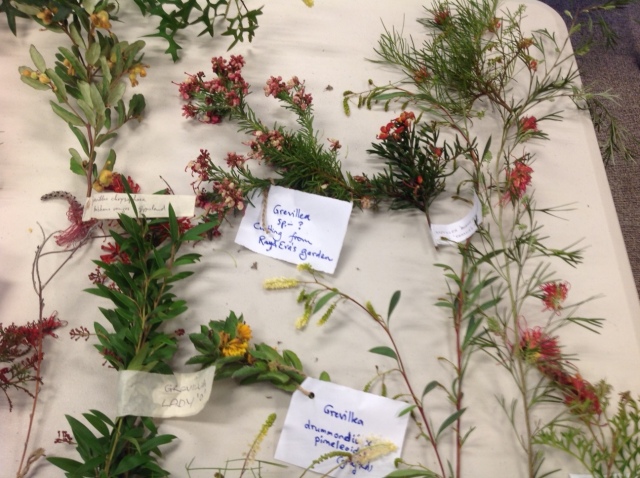

Devilbend Planting
The Annual Planting Day with Ranger Sam Pollard at Devilbend Reservoir was held on a cold day with blue skies on Saturday 29th July. Along with several others our group was involved again. It’s amazing how quickly you can plant a tray of tube stock using one of the Hamilton planting tools. Thanks to those who helped out.

Plant of the Month – August
This month Verena has sent me two photos of her spectacular Acacia denticulosa (Sandpaper wattle). Verena says it was planted as a small tube specimen in mid 2014, in extremely poor water-repellant yellow sand but in the sunniest spot in the garden. It has received infrequent small amounts of water in Summer for 2 years. Spindly to start but with judicious tip pruning has grown many more branches. Flowers from July to September, best in August. Have seen it growing well in Maranoa Gardens in well-drained clay soil. Difficult to make a photo of its intense bright yellow that lifts the gloom of Winter.
It certainly looked great on the plant table too.

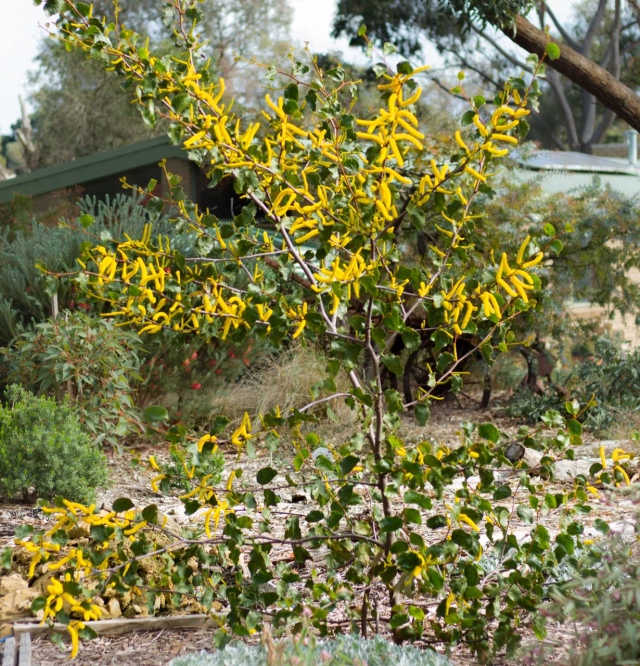
August meeting
Lake Eyre – Verena Reich
Due to a last minute cancellation our leader Verena stepped into the breach and gave us an entertaining and informative talk about her trip to see Lake Eyre in flood. Now all we need is for the lake to be flooded again and to have the time and money to go and see for ourselves.
Warrangine Walk
Just under 20 of our members gathered just before 10:30am at Warragine Reserve on Saturday 16th September for a post burn walk with Mornington Peninsula Shire Ranger Matt Stahmer, plus Anthony Fennel from Nature Links. Back in early January 2015 a blaze burnt through the area along the Warrangine walk so this was a good chance to see how things had recovered.

Lots of burnt trees remain but new growth was very evident.

We were certainly in the hands of two knowledgable men, passionate for their local environment.
It was a good walk enhanced by the opportunity to learn more about the local environment.

Plant of the Month – September
After being planted from tube nearly two years ago we were delighted to see not only a spurt in growth but some lovely yellow flowers erupting from our Hibbertia racemosa this spring. It is growing in quite heavy soil/clay but seems to be doing well now and stands at about 40cms so far.

Frankston gardens – Saturday 7th October
Members had a double delight when they were able to visit the garden of one of our members, Brenda Martin, as well as Frankston’s George Pentland Botanic Gardens on Saturday 7th October. Thanks to member, Sonya Bunting for her thoughts. Sonya was a bit restricted for time and couldn’t go on from Brenda’s garden with the group but managed to return to see the botanic gardens later.
“Brenda’s garden was compact but beautifully laid out, and made quite an impression on her visitors. It was a surprise package of private spaces which were beautiful to meander through and also must be a delight to view from within her home, at the front, side and back. She has made excellent use of the slope of the block with large rocks in her landscaping, layered planting and a charming rock water feature trickling into a pond. Brenda also made great use of pots on her paving. She had a stunning example of one of my favourites ‘Eremophila Nivea’ in full bloom with its elegant silver foliage. Brenda’s garden showed how beautiful an Australian native garden can be with sympathetic landscaping, good planning and an interesting selection of flowering trees, shrubs and ground covers. Further around the back we found the productive part of the garden with citrus and veggies, then the hub of the garden – the potting table. Brenda was a wonderful host for the open garden, and is an inspiration to me as a native garden novice.”



Plant of the Month – October

Pileanthus nitidus (Copper Cups) was providing Verena with a beautiful display during October. Thanks for sharing Verena. Remember, if you have a plant in your garden providing a great show then email me a copy (less than 1Mb please), let me know a few details and I’d love to include it in one of our newsletters. Email to- mornpenaps@gmail.com marking it Attention:Mark Allison
Tuesday 17th October
Topic: Fire Reduction Burning
On Tuesday 17th October Damien Sayer ranger in charge of fire and emergency operations at DWELP for the south East Melbourne district, talked to a substantial, interested audience about his job. Thanks to member, Robyn Tyson, for this report and for the photos from the plant table.
Featured items from the plant table-


A Trip To Pomonal Native Flower Show
The Pomonal Native Flower Show was, as usual, absolutely stunning in the sheer number and variety of species (more than 300) picked from private gardens in the local area. The mind boggles at the amount of work the committee must have to do to put on the show each year. Our thanks go out to them. Alongside the show was an excellent selection of books for sale relating to native plants and in the immediate area of the hall where the wildflowers were displayed several growers of Australian native plants had stalls. These included two of Australia’s most expert growers in Phil Vaughan and Neil Marriott, so yes of course we came away with a few unusual Grevilleas to help attract honeyeaters to our garden.
Our stay was in a cottage overlooking a paddock and when we arrived a flock of fifty or more sulphur crested cockatoos were grazing close by and in and amongst them were a dozen or so roos, one or two with joeys in their pouches and early next morning there were roos all over the paddock, again numbering at least fifty.
Over the weekend we were particularly pleased to greet a couple of other APS members from our Mornington group, one of whom was first sighted kneeling on the ground with her posterior in the air. It turned out that she was taking a close up photo of a spider orchid and since photography was also one of our objectives we were soon also similarly recumbent.
At this time of year the Grampians offer the most amazing number and variety of wild flowers, particularly orchids. The accompanying photos and many many more were all taken close by Lake Fyans in an area no larger than a tennis count. Over the weekend there are also several Wildflower walks guided by locals. Our identification of the orchids is pretty well guess work so if you have a go yourself you’ll be just as accurate.



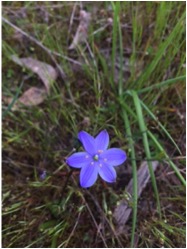
We unreservedly recommend The Pomonal Native Flower Show as one of the great APS Victoria events of the year.
– Philip and Moira Robinson
Tuesday 21st November
Topic: Landscape Architecture
Our speaker was Barrie Gallacher, MA Landscape Architecture, who presented us with an informative talk about the role of a landscape architect and in particular he detailed to us some of the projects he has been in charge of over the length of his career. He started with a major project for a middle eastern monarch and continued showing us several Australian projects, some using indigenous plants as well as Australian natives of a broader origin. Barrie was happy to answer questions from a full meeting room of members.
Here are a couple of photos of specimens that were on the plant table.


Plant of the Month – November
This month’s featured plant is from Sue Gilbert’s garden. Sue says, “this picture of one of my favourite small plants in my garden. It’s a Thelionema caespitosum, (tufted lily) and it probably keeps flowering for about a month. I just love the colour of the flowers. They really are an electric blue. It’s now quite rare on the Mornington Peninsula. Mine’s growing in dappled to full sun, and l tend to water it regularly during the summer, as it prefers moist soils.”

Link to Inverawe Gardens newsletter
Several of our members have visited Inverawe Gardens in Margate whilst holidaying in Tasmania. They are a wonderful example of a large Australian garden open to the public. The owners, Bill and Margaret Chestnut, produce an interesting newsletter. If you’d like to check them out here’s the address – http://www.inverawe.com.au/newsarchive.html
Surprise development
Ray and Eva Turner had some surprises in their garden recently. Here is Ray’s report of the discovery with some photos.
“Recently we had our first kangaroo sighting. It was kind enough to give me time to get my camera and then hop up towards the house and stop so I could get a couple of photos. Whilst out I noticed a dead branch on the drive. On it was some mistletoe, Amyena pendular. It was just a stroke of luck that I noticed them when I picked up the branch on the drive. I have been trying to get some information since about transplanting as they would have no hope on a dead stick. I can’t find anything on Google about it and with my enquiries to some learned people, they all have different and conflicting ideas. The only thing I’ve learnt so far is don’t use honey as it’s an antiseptic and it will probably kill them quicker. Anyway, amazingly the photos I took of the two baby stages turned out pretty good and I think fairly interesting with the green growing tips. Now I guess the challenge is to find a live branch to try to relocate them and give them a fighting chance to survive.”
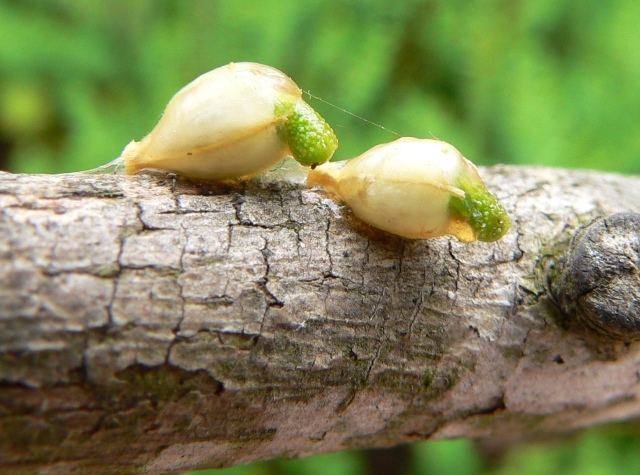

Coming up – Christmas break up lunch
Sunday 10th December at our leader, Verena Reich’s, house and garden – 24 Mashie Court, Rosebud. Bring a plate of food to share and a chair to sit on. Dessert, wine, water, tea and coffee provided. BYO other drinks. Hope you can be there.
Happy Christmas to all. May you and your garden prosper in 2018.
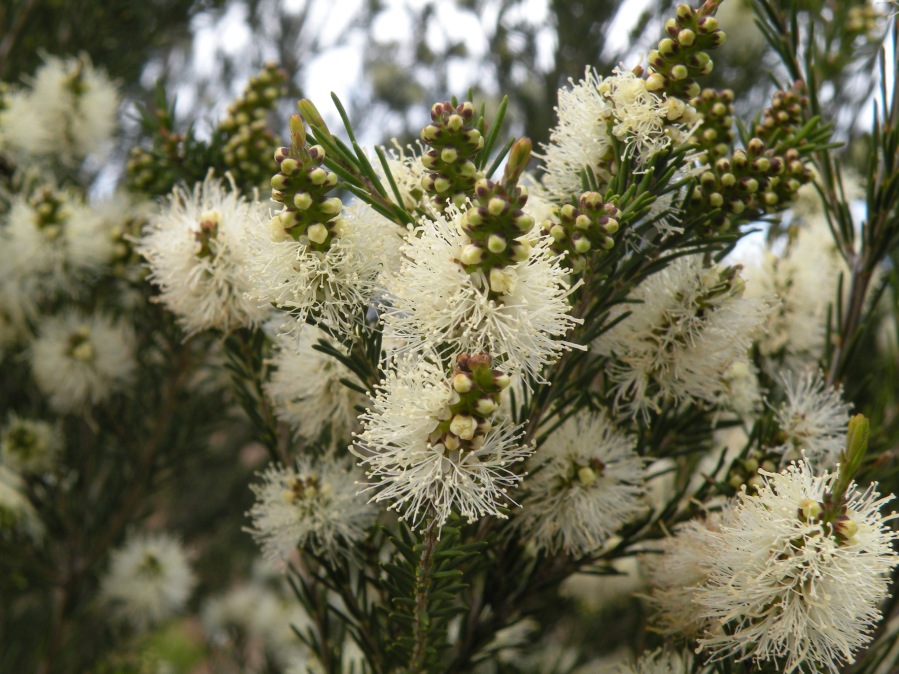
As I looked at my orchids, in Lincolnshire UK, I was particularly delighted to read the article by Phil and Moira Robinson on the Pomonal Native Flower Show. What a spectacle they have described, I have addedit to my bucket list. Iris Longmate (aged 90 Dunston Lincolnshire, UK
LikeLike